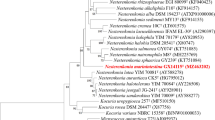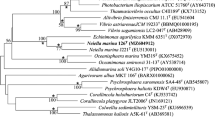Abstract
A novel Gram-negative bacterium, non-motile and short rod-shaped, designated strain GY511T, was isolated from the intestines of fish collected from Maowei Sea, China. Growth occurred at pH 6.0–9.0 (optimum 7.0), 4–37 °C (optimum 28 °C) and at 0–2.5% (w/v) NaCl (optimum 1.0%). The result of 16S rRNA gene sequence analysis showed that strain GY511T is closely related to O. oryzae NBRC 113109T (97.6%), O. konkukae DSM 105395T (97.4%), Ottowia beijingensis CGMCC 1.12324T (95.9%), Ottowia pentelensis DSM 21699T (95.2%) and Ottowia thiooxydans DSM 14619T (95.0%). The DNA–DNA hybridization values of strain GY511T with O. oryzae NBRC 113109T and O. konkukae DSM 105395T were 35.4 ± 3.1% and 26.3 ± 1.8%, respectively. The major fatty acids (> 10%) were identified as summed feature 3 (C16:1ω7c and/or C16:1ω6c), C16:0 and summed feature 8 (C18:1ω7c and/or C18:1ω6c) and the major respiratory quinone was ubiquinone-8 (Q-8). The polar lipids comprised diphosphatidylglycerol, phosphatidylethanolamine, phosphatidylglycerol, phosphatidylmethylethanolamine, two unidentified aminolipids and an unidentified phospholipid. The G+C content of the genomic DNA was 62.9 mol%. Thiosulfate could be utilized as co-substrate for aerobic growth and was oxidised to sulfate. On the basis of phenotypic, chemotaxonomic and molecular data, strain GY511T is considered to represent a novel species of the genus Ottowia, for which the name Ottowia flava sp. nov. is proposed. The type strain is GY511T (= NBRC 113500T = DSM 107425T = CGMCC 1.13650T).

Similar content being viewed by others
References
Buck JD (1982) Nonstaining (KOH) method for determination of gram reactions of marine bacteria. Appl Environ Microbiol 44:992–993
Cao J, Lai Q, Liu Y, Li G, Shao Z (2014) Ottowia beijingensis sp. nov., isolated from coking wastewater activated sludge, and emended description of the genus Ottowia. Int J Syst Evol Microbiol 64:963–967
Christensen H, Angen O, Mutters R, Olsen JE, Bisgaard M (2000) DNA–DNA hybridization determined in micro-wells using covalent attachment of DNA. Int J Syst Evol Microbiol 50:1095–1102
Collins MD, Pirouz T, Goodfellow M, Minnikin DE (1977) Distribution of menaquinones in actinomycetes and corynebacteria. J Gen Microbiol 100:221–230
Ezaki T, Hashimoto Y, Yabuuchi E (1989) Fluorometric deoxyribonucleic acid-deoxyribonucleic acid hybridization in microdilution wells as an alternative to membrane filter hybridization in which radioisotopes are used to determine genetic relatedness among bacterial strains. Int J Syst Bacteriol 39:224–229
Felföldi T, Kéki Z, Sipos R, Márialigeti K, Tindall BJ, Schumann P, Tóth EM (2011) Ottowia pentelensis sp. nov., a floc-forming betaproteobacterium isolated from an activated sludge system treating coke plant effluent. Int J Syst Evol Microbiol 61:2146–2150
Felsenstein J (1981) Evolutionary trees from DNA sequences: a maximum likelihood approach. J Mol Evol 17:368–376
Felsenstein J (1985) ConfIdence limits on phylogenies: an approach using the bootstrat. Evolution 39:783–791
Fitch WM (1971) Toward defining the course of evolution: minimum change for a specific tree topology. Syst Zool 20:406–416
Geng S, Pan XC, Mei R, Wang YN, Sun JQ, Liu XY, Tang YQ, Wu XL (2014) Ottowia shaoguanensis sp. nov., isolated from coking wastewater. Curr Microbiol 68:324–329
Gonzalez C, Gutierrez C, Ramirez C (1978) Halobacterium vallismortis sp. nov., an amylolytic and carbohydrate-me-tabolizing, extremely halophilic bacterium. Can J Microbiol 24:710–715
Hasegawa T (1983) A rapid analysis for chemical grouping of aerobic actinomycetes. J Gen Appl Microbiol 29:319–322
Heo J, Cho H, Honq SB, Kim JS, Kwon SW, Kim SJ (2018) Ottowia oryzae sp. nov., isolated from Andong sikhye, a Korean traditional rice beverage. Int J Syst Evol Microbiol 68:3096–3100
Kim SB, Brown R, Oldfield C, Gilbert SC, Iliarionov S, Goodfellow M (2000) Gordonia amicalis sp. nov., a novel dibenzothiophene-desulphurizing actinomycete. Int J Syst Evol Microbiol 50:2031–2036
Kimura M (1980) A simple method for estimating evolutionary rates of base substitutions through comparative studies of nucleotide sequences. J Mol Evol 16:111–120
Kovacs N (1956) Identification of pseudomonas pyocyanea by the oxidase reaction. Nature 78:703
Kroppenstedt RM (1982) Separation of bacterial menaquinonesby HPLC using reverse phase (RP18) and a silver loadedion exchanger as stationary phases. J Liq Chromatogr 5:2359–2367
Kumar S, Stecher G, Tamura K (2016) MEGA7: molecular evolutionary genetics analysis version 7.0 for bigger datasets. Mol Biol Evol 33:1870–1874
Kuykendall LD, Roy MA, O’Neill JJ, Devine TE (1988) Fatty acids, antibiotic resistance, and deoxyribonucleic acid homology groups of bradyrhizobium japonicum. Int J Syst Bacteriol 38:358–361
Li WJ, Xu P, Schumann P, Zhang YQ, Pukall R, Xu LH, Stackebrandt E (2007) Georgenia ruanii sp. nov., a novel actinobacterium isolated from forest soil in Yunnan (China), and emended description of the genus georgenia. Int J Syst Evol Microbiol 57:1424–1428
Mergaert J, Cnockaert MC, Swings J (2002) Fulvimonas soli gen. nov., sp. nov., a gamma-proteobacterium isolated from soil after enrichment onacetylated starch plastic. Int J Syst Evol Microbiol 52:1285–1289
Mesbah M, Premachandran U, Whitman WB (1989) Precise measurement of the G+C content of deoxyribonucleic acid by high performance liquid chromatography. Int J Syst Bacteriol 39:159–167
Minnikin DE, O’Donnell AG, Goodfellow M, Alderson G, Athalye M, Schaal A, Parlett JH (1984) An integrated procedure for the extraction of bacterial isoprenoid quinones and polar lipids. J Microbiol Methods 2:233–241
Saitou N, Nei M (1987) The neighbor-joining method: a new method for reconstucting phylogenetic trees. Mol Biol Evol 4:406–425
Smibert RM, Krieg NR (ed) (1994) Phenotypic characterization. In: Methods for general and molecular bacteriology. American Society for Microbiology, Washington, pp 607–654
Spring S, Jackel UM, Kampfer P (2004) Ottowia thiooxydans gen. nov., sp nov., a novel facultatively anaerobic, N2O-producing bacterium isolated from activated sludge, and transfer of Aquaspirillum gracile to Hylemonella gracilis gen. nov., comb. nov. Int J Syst Evol Microbiol 54:99–106
Xu P, Li WJ, Tang SK, Zhang YQ, Chen GZ, Chen HH, Xu LH, Jiang CL (2005) Naxibacter alkalitolerans gen. nov., sp. nov., a novel member of the family ‘oxalobacteraceae’ isolated from China. Int J Syst Evol Microbiol 55:1149–1153
Yi KJ, Im WT, Kim DW, Kim SK (2018) Ottowia konkukae sp. nov., isolated from rotten biji (tofu residue). Int J Syst Evol Microbiol 68:3458–3462
Yoon SH, Ha SM, Kwon S, Lim J, Kim Y, Seo H, Chun J (2017) Introducing EzBiocloud: a taxonomically united database of 16S rRNA gene sequences and whole-genome assemblies. Int J Syst Evol Microbiol 67:1613–1617
Acknowledgements
This research was funded by National Natural Science Foundation of China (Nos. 31460005 and 31660005) and supported by Major research Project of Guangxi for science and technology (AA18242026), Guangxi Natural Science Foundation Project (2016GXNSFAA380075), Scientific and technological breakthrough in Nanning (20153330), Science and technology base and talent special in Guangxi (AD18126005), Xiangsihu Young Scholars Innovative Research Team of Guangxi University for Nationalities (2017) and Innovation Project of Guangxi Graduate Education (No.gxun-chxzs 2017123).
Author information
Authors and Affiliations
Contributions
S-BS: performed research and wrote the paper; G-DL: analyzed data; L-FY: guide experiment; CL; Collection of samples; M-GJ: designed study; Q-YL: analyzed data; J-FW: collection of samples and performed research; KZ: performed research; L-QJ: performed research; N-KS: collection of samples; C-LJ: designed study; YJ: designed study and wrote the paper.
Corresponding authors
Ethics declarations
Conflict of interest
The authors declare that they have no conflict of interest.
Ethical standard
This article does not describe any experimental work related to human.
Additional information
Publisher's Note
Springer Nature remains neutral with regard to jurisdictional claims in published maps and institutional affiliations.
Electronic supplementary material
Below is the link to the electronic supplementary material.
Rights and permissions
About this article
Cite this article
Shi, SB., Li, GD., Yang, LF. et al. Ottowia flava sp. nov., isolated from fish intestines. Antonie van Leeuwenhoek 112, 1567–1575 (2019). https://doi.org/10.1007/s10482-019-01284-6
Received:
Accepted:
Published:
Issue Date:
DOI: https://doi.org/10.1007/s10482-019-01284-6




